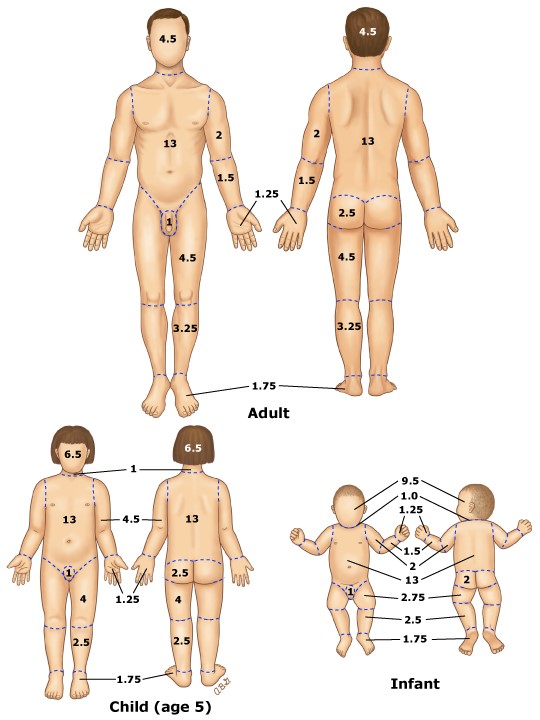A patient experiences a gasoline tank fire when riding a motorcycle and is admitted to the emergency department (ED. with partial-thickness burns on the anterior surfaces of both lower extremities. Which percentage of body surface area should the nurse document in the electronic medical record (EMR)?
18%.
45%.
9%.
36%.
The Correct Answer is A
Choice A reason: This is the correct answer. According to the rule of nines, each leg accounts for 18% of the total body surface area, and the anterior surface of each leg accounts for half of that, or 9%. Therefore, the patient has partial-thickness burns on 9% + 9% = 18% of the body surface area.
Choice B reason: This is incorrect. This would be the case if the patient had partial-thickness burns on the anterior and posterior surfaces of both legs, as well as the head and neck, which is not given in the question.
Choice C reason: This is incorrect. This would be the case if the patient had partial-thickness burns on the anterior surface of only one leg, which is not given in the question.
Choice D reason: This is incorrect. This would be the case if the patient had partial-thickness burns on the anterior and posterior surfaces of both legs, which is not given in the question.

Nursing Test Bank
Naxlex Comprehensive Predictor Exams
Related Questions
Correct Answer is A
Explanation
Choice A reason: This is correct because it addresses both the physical and emotional needs of the child and the mother. The nurse should provide comfort and reassurance to the mother and explain that occasional accidents are normal and not a sign of failure.
Choice B reason: This is incorrect because it implies that the mother is incompetent and needs external help. The nurse should first establish rapport and trust with the mother before suggesting any resources or interventions.
Choice C reason: This is incorrect because it suggests that there is something wrong with the child's kidneys, which may alarm and offend the mother. The nurse should not jump to conclusions without assessing the child's history and symptoms.
Choice D reason: This is incorrect because it generalizes and stereotypes boys as being slower than girls in toilet training. The nurse should not make assumptions based on gender and should respect individual differences.
Correct Answer is A
Explanation
Choice B reason: Forcing oral fluids and providing frequent small meals are not the most important interventions for a client with alcohol withdrawal delirium. Although hydration and nutrition are important to prevent dehydration and electrolyte imbalance, they are not the priority in this case. The client may have difficulty swallowing, vomiting, or aspiration due to altered mental status.
Choice C reason: Confronting the client's denial of substance abuse is not an appropriate intervention for a client with alcohol withdrawal delirium. The client may not be able to comprehend or respond rationally to such confrontation due to impaired cognition and perception. The nurse should avoid arguing or challenging the client's beliefs and focus on providing safety and comfort.
Choice D reason: Encouraging attendance and group participation is not a feasible intervention for a client with alcohol withdrawal delirium. The client may not be able to participate in any social or educational activities due to severe withdrawal symptoms and delusions. The nurse should limit visitors and stimuli and provide one-to-one supervision and reassurance.
Whether you are a student looking to ace your exams or a practicing nurse seeking to enhance your expertise , our nursing education contents will empower you with the confidence and competence to make a difference in the lives of patients and become a respected leader in the healthcare field.
Visit Naxlex, invest in your future and unlock endless possibilities with our unparalleled nursing education contents today
Report Wrong Answer on the Current Question
Do you disagree with the answer? If yes, what is your expected answer? Explain.
Kindly be descriptive with the issue you are facing.
